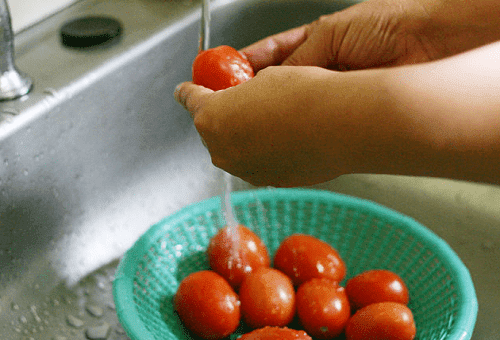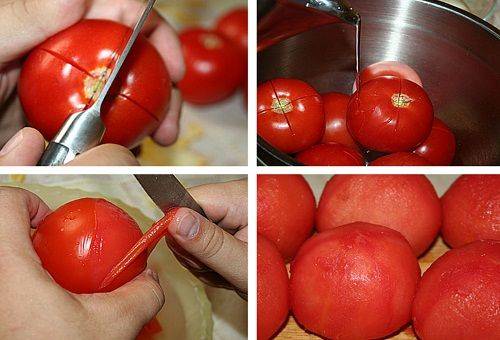How to quickly peel the skin of tomatoes
The vast majority of recipes that include tomatoes require you to first remove the thick peel from the juicy vegetable. To facilitate the process, many approaches have been developed to peel ripe or slightly unripe tomatoes. In most cases, exposure to high temperatures is used, so you will have to act quickly. Any delay will negatively affect not only the physical condition of the pulp, but will also deprive it of many useful components.

Professional chefs consider baking tomatoes in the oven to be the best option. This allows you to preserve a maximum of vitamins and microelements in them, while making it easier to remove the skin.
If time does not allow you to wait long, you can resort to one of the high-speed methods: treatment with boiling water, heating over a fire, or mechanical cleaning.
How to properly use boiling water when peeling tomatoes?
To peel tomatoes in a few seconds and in large quantities at once, you need to prepare two bowls - one with boiling water and one with ice water (even adding a few ice cubes is allowed). The manipulation is carried out according to the following scheme:
- We make small cross-shaped cuts on both sides of the tomatoes with a very sharp knife. You only need to use the skin, being careful not to damage the flesh.
- Place the vegetables in a container with boiling water and leave for 20-30 seconds. If the products are not very ripe, then the holding time can be increased to a minute, after which they will begin to cook.
Tip: It is recommended to lay out the tomatoes, and not to fill them with hot water. Scalded fruits will peel off the skin much faster, but during subsequent cleaning it will peel off unevenly, which will greatly complicate the processing process.
- As soon as the cut edges of the skin are wrapped, we take out the fruits. Then we transfer them to ice water for just a few seconds.
- We drain the liquid and begin to remove the skin. Vegetables should not be left in cold water; their taste and texture will change.
If all stages of manipulation were carried out correctly, then the skin can be easily removed with the blunt side of a knife. If difficulties arise with cleaning, the procedure can be repeated.
Gas and microwave options
If desired, you can do without boiling water, but again using high temperatures. If you need to peel a small amount of tomatoes, an open fire or microwave will help.
- Cleaning using a gas torch. This approach allows you to remove the skin from a tomato quite quickly, but you will have to work with each vegetable separately. We take the fruit, wash it in cold water and dry it. We thread the product onto a fork with the side with the stem on it; it should hold very tightly. Turn on the smallest burner and place a tomato over it at a distance of a couple of centimeters from the fire. We rotate it slowly, ensuring uniform heating on all sides; manipulation should not take more than 20-30 seconds. After the specified time, the skin should become covered with blisters, which means it can be removed after cooling the product.
- Microwave cleaning. Wash the tomatoes in cool water and dry thoroughly.We make small cuts on each vegetable, process the poles and even the sides. Then we lay out the preparations on a plate with a flat bottom, which we place in the microwave. Set the heating mode for 30 seconds and wait for the result. During this time, the skin will have time to heat up, and it will begin to lag behind the pulp. All that remains is to clean the product from its flaps.
When using these options, you must strictly observe the holding time, otherwise the products may burn, juice will leak, and the pulp will begin to break down. If after the first approach it was not possible to carefully remove the skin, it is better not to repeat the heating, but to immediately begin peeling the vegetable with a dull knife.
Peeling tomatoes with a knife
This technique is not used very often, and only when working with very ripe tomatoes. But it allows you to clean the fruit without exposure to high temperatures and fully preserve its benefits. Processing will be carried out individually, but first it is recommended to rinse, dry and cut all products into four parts. Next, take one tomato slice at a time, grab the edge of the skin with a blunt knife and gently pull, removing the flaps. If the tomato is ripe, the skin will come off without problems, but in some cases it will have to be trimmed.
If the product is not very ripe, then another technique will be more suitable. Place the quarters on a cutting board, skin side down, take a very sharp knife and begin cutting out the flesh, bringing the blade as close to the skin as possible. You should not peel a tomato like a potato; this arrangement of the tool and product will allow you to preserve the pulp as much as possible.
In addition, there is a special knife for peeling tomatoes, although it will take a lot of work to master the relevant skills.A regular vegetable peeler will only spoil the product by cutting off too much pulp from its surface and releasing juice.



